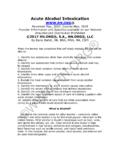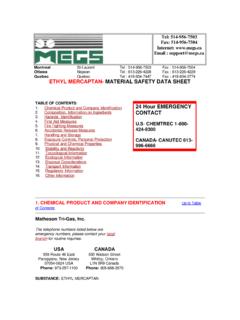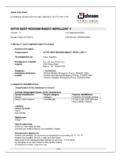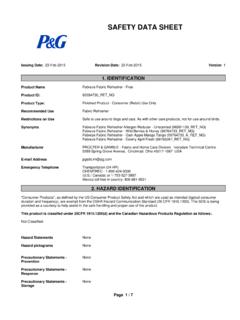Transcription of PÙÊ ç ã N Ã : ETHYL ALCOHOL (ANHYDROUS) …
1 P N : ETHYL ALCOHOL ( anhydrous ) Page 1 of 6 MSDS NO: 1009 E D : February 1, 2014 MATERIAL SAFETY DATA SHEET M B : Commercial alcohols Bruce Energy Centre 275 Bloomfield Road 2 Chelsea Lane 4th Concession Chatham, Brampton, Ontario Tiverton, Ontario Ontario L6T 3Y4 N0G 2T0 N7M 5J5 E P N : C (613) 996 6666 T I. E F A P I Never give anything by mouth if vic m is rapidly losing consciousness or is unconscious or convulsing. DO NOT INDUCE VOMITING.
2 Have vic m drink about 250ml (8fl. oz.) of water to dilute material in stomach. If vomi ng occurs naturally, have vic m lean forward to reduce risk of aspira on. Seek medical assistance. S Flush contaminated area with water for at least 20 minutes. Remove contaminated clothing under running water. Completely decontaminate clothing before re use, or discard. If irrita on occurs seek medical a en on. I Remove vic m to fresh air. Ar ficial respira on should be given if breathing has stopped and cardiopulmonary resuscita on if heart has stopped. Oxygen may be given if necessary. Seek medical a en on immediately. E Immediately flush eyes with water for at least 20 minutes, holding the eyelids open. Seek medical a en on immediately. N T P Symptoms of ethanol intoxica on vary with the ALCOHOL level of the blood.
3 Mild ALCOHOL intoxica on occurs at blood levels between and approximately 25% of individuals will show signs of intoxica on at these levels. Above the person is definitely under the influence of ethanol and 50 95% of individuals at this level are clinically intoxicated. Severe poisoning occurs when the blood ethanol level is Above the individual will be comatose and death can occur. The unabsorbed ethanol should be removed by gastric lavage a er intuba ng the pa ent to prevent aspira on. Avoid the use of depressant drugs or the excessive administra on of fluids. THE INFORMATION AND RECOMMENDATIONS CONTAINED HEREIN ARE BASED UPON DATA BELIEVED TO BE CORRECT. HOWEVER, NO GUARANTEE OR WARRANTY OF ANY KIND, EXPRESSED OR IMPLIED, IS MADE WITH RESPECT TO INFORMATION AND RECOMMEN DATIONS CONTAINED HEREIN.
4 PRIMARY CLASS: 3 CLASS NAME: FLAMMABLE LIQUID UN#: 1170 SUBSIDIARY CLASS: NONE SHIPPING NAME: ETHANOL P N : ETHYL ALCOHOL ( anhydrous ) Page 2 of 6 MSDS NO: 1009 E D : February 1, 2014 MATERIAL SAFETY DATA SHEET II. F E H D F P , oC 13 (Tag closed cup, ASTM D 56) O I D - E M Apply ALCOHOL type or all purpose type foams by manufacturers' recommended techniques for large fires. Use carbon dioxide or dry chemical media for small fires. Water is generally unsuitable and may help to spread the fire. S F F P Use water spray to cool fire exposed containers and structures.
5 Use water spray to disperse vapours; reigni on is possible. Use self contained breathing apparatus and protec ve clothing. U F E H Vapours form from this product and may travel or be moved by air currents and ignited by pilot lights, other flames, sparks, heaters, electrical equipment, sta c discharges or other igni on sources at loca ons distant from handling point. COMPONENT % V/V VAPOUR PRESSURE VAPOUR DENSITY AUTOIGNI TION LOWER UPPER KPA AT 20oC (AIR = 1) POINT, oC (1) ETHYL ALCOHOL 100 422 III. I C N ETHYL ALCOHOL ( anhydrous ) C F alcohols F (1) CH3 CH2 OH M W (1) S U General purpose organic solvent, aerosols, cosme cs, pharmaceu cals, etc. Ethanol, Absolute Ethanol, ALCOHOL , ETHYL ALCOHOL 200 proof, ETHYL ALCOHOL DPS anhydrous , ETHYL ALCOHOL DS anhydrous .
6 P N : ETHYL ALCOHOL ( anhydrous ) Page 3 of 6 MSDS NO: 1009 E D : February 1, 2014 MATERIAL SAFETY DATA SHEET A A O Colourless liquid with typical lower ALCOHOL odour. Odour threshold is in the range of to 5100 ppm, according to the Canadian Standards Associa on publica on M1982 (Appendix 1). IV. P D BOILING POINT, oC at 760mm Hg FREEZING POINT, oC DENSITY, kg/L @ 20oC COEFFICIENT OF WATER/OIL DISTRIBUTION Separates from oil pH Not applicable DISTILLATION RANGE, oC MISCIBILITY IN WATER Complete % VOLATILES BY VOLUME 100 EVAPORATION RATE (butyl acetate = 1) V. I T D R : ACGIH (1988 1989), RTECS (1983).
7 INGREDIENT % V/V CAS NO. TLV, ppm LC50, ppm/4h. LD50, mg/kg LD50, mg/kg RAT, INHAL. RAT, ORAL RABBIT, SKIN (1) ETHYL ALCOHOL 64 17 5 1000 31,623 7,060 20,000 VI. WHMIS C S M WHMIS C Flammable liquid, eye irritant. S M Carbon tetrachloride, chloroform, bromotrichloromethane, dimethylnitrosamine, P N : ETHYL ALCOHOL ( anhydrous ) Page 4 of 6 MSDS NO: 1009 E D : February 1, 2014 MATERIAL SAFETY DATA SHEET VII. H H D I May cause dizziness, faintness, drowsiness, decreased awareness and responsiveness, euphoria, abdominal discomfort, nausea, vomi ng, staggering gait, lack of coordina on and coma.
8 S A No adverse effects with normal skin. However, poten ally harmful amounts of material may be absorbed across markedly abraded skin when contact is sustained, par cularly in children. I High vapour concentra ons may cause a burning sensa on in the throat and nose, s nging and watering in the eyes. At concentra ons which cause irrita on, dizziness, faintness, drowsiness, nausea and vomi ng may occur. S C No evidence of adverse effects from available informa on. Severe eye irritant. Vapours can irritate eyes. Eye damage from contact with liquid is reversible and proper treatment will result in healing within a few days. Damage is usually mild to moderate conjunc vi s, seen mainly as redness of the conjunc va. Long term repeated oral exposure to ethanol may result in the development of progressive liver injury with fibrosis.
9 M C A B O Repeated exposure to ethanol may exacerbate liver injury produced from other causes. Repeated inges on of ethanol by pregnant mothers has been shown to adversely affect the central nervous system of the fetus, producing a collec on of effects which together cons tute the fetal ALCOHOL syndrome. These include mental and physical retarda on, disturbances of learning, motor and language deficiencies, behavioral disorders, and small size head. EYE C EFFECT OF REPEATED OVEREXPOSURE O P N : ETHYL ALCOHOL ( anhydrous ) Page 5 of 6 MSDS NO: 1009 E D : February 1, 2014 MATERIAL SAFETY DATA SHEET VIII.
10 R D S Stable C A Sources of igni on I Oxidizing materials H C D P Burning can produce carbon monoxide and/or carbon dioxide and/or formaldehyde. H P Will not occur C A None currently known IX. S L P S Contain spilled material. Provide adequate ven la on and protec ve equipment. Remove sources of heat, sparks or flames. Spill should be collected in suitable containers or absorbed on a suitable absorbent material for subsequent disposal. W D Waste material should be disposed of in an approved incinerator or in a designated landfill site, in compliance with all federal, provincial and local government regula ons. X. S P I Up to 1000 ppm, an approved organic vapour cartridge respirator can be used.





